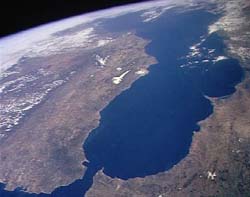Mediterranean Sea
The story of the Mediterranean Sea.
Seas of the World - The Mediterranean
Mediterranean Sea: Connected to the Atlantic Ocean at the Strait of Gibraltar, but otherwise almost totally enclosed by land, the Mediterranean Sea has a surface area of 2,500,000 square kilometres and a maximum depth of 17,280 feet. In terms of area it is the 7th largest sea in the world.
Taking its name from the Latin for “Middle Earth”, it lies between the land areas of Europe and Africa and is divided into marine sub-areas such as the Aegean Sea, the Adriatic Sea, the Balearic Sea, the Ionian Sea, the Levantine Sea and the Tyrrhenian Sea.
The Mediterranean Sea has borders on a large number of European, African and Middle Eastern countries and has hundreds of islands and islets of which the largest are Sicily, Sardinia, Cyprus, Malta, Corsica, Crete, Mallorca, Evvoia, Lesbos and Rhodes.
The largest island by population is Sicily with 4,937,301, the most visited island is Mallorca in the Spanish Balearic Islands, and the country with the longest Mediterranean coastline is Greece with 18,400 kilometres.
The 21 modern countries which border the Mediterranean Sea are Spain, Morocco, Algeria, Tunisia, Libya, Egypt, France, Italy, Monaco, Greece, Turkey, Croatia, Slovenia, Montenegro, Malta, Bosnia and Herzegovina, Albania, Israel, Lebanon, Cyprus and Syria.
The Mediterranean Sea evolved during the Mesozoic and Cenozoic eras, as movements occurred between the land masses of Africa, Eurasia and North America, it filled with water around 5.3 million years ago, as water rushed in from the Atlantic Ocean. Volcanic activity formed most of its islands, some of the oldest being the Spanish Balearic Islands which appeared during the Upper Oligocene.
The Mediterranean Sea has had a huge influence on human history as most of the world’s ancient civilisations, developed on the lands which border it. Merchants and travellers have sailed between its various regions, and historic ports have been established along its coastline. Egyptians, Ancient Greeks, Phoenicians, Romans, Moors and Carthaginians (to name but a few), have sailed, fought, conquered and traded along its shores.
Mediterranean Sea - The Islands:
Sicily: The largest island in the Mediterranean Sea, Sicily is also the largest autonomous region of Italy with an area of 25,708 square kilometres and a population of over 5 million. An important strategic location on the Mediterranean shipping route, Sicily has for many centuries had great significance.
Malta: The Republic of Malta comprises 7 islands, with a population of around 420,000, located to the south of Sicily in the Mediterranean Sea. In an important strategic location, Malta has been settled over the centuries by various cultures and civilizations including Sicilians, Phoenicians, Romans and Byzantines.
The 2nd largest island in the Mediterranean Sea after Sicily, Sardina is located off the west coast of Italy and has an area of 24,090 km2 and a population of approximately 1,665,000. Probably settled since the Palaeolithic Period, Sardinia's first civilization seems to have been around 1500 BC, when known as Hyknusa by the Mycenaeans, it was populated by some peoples expelled from Egypt, among its earliest settlers were a race known as the Nuraghe.
Cyprus: The 3rd largest island in the Mediterranea Sea, Cyprus has a resident population of around 800,000 and has a long and interesting history, being settled since around 10,000 BC, it has many sites of archaeological and historical interest, and is now one of the regions most popular tourist destinations.
Crete: The largest of the Greek Islands with an area of 8,260km2, Crete is also the 5th largest island in the Mediterranean Sea. Crete is around 260 kilometres long and about 56 kilometres across at its widest point, it has a population of approximately 600,000 and its currency is the euro. Crete has a long and interesting history going back some 8,000 years, with artefacts being found on the island dating from 6,000 BC.
Related: Travel Articles - Builders
HOME
